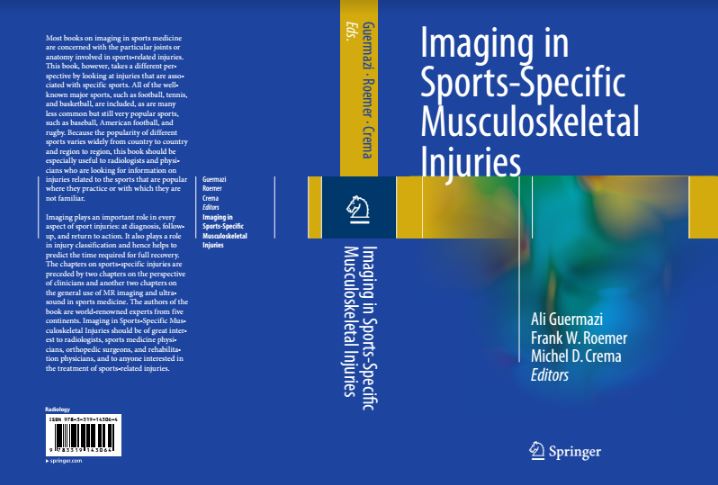By Karim Khan (@BJSM_BMJ) and Hakim Chalabi
(This blog is based on the published preface for the book – it’s not a new piece of writing. Think of BJSM going green – re-use, refresh, re-edit (a bit)).
Wow!!! Wow!!! Wow!! As experienced sports physicians we have seen most of the injuries, we have listened to very many lectures and we own many books. We have perused a zillion sports medicine books at conferences, academic bookstores and among our friends/colleagues’ collections. So when we heard that Professor Guermazi and Doctors Roemer and Crema were writing a sports medicine radiology book we were pleased but we were not expecting to be surprised.

Comprehensive!! We were not expecting 776 pages. This is encyclopedic but also very friendly to access. With 27 chapters, all the common sports are, of course, included but you can also learn about the imaging of rodeo and climbing sports injuries, for example.
Sporting focus!! The first wave of sports medicine books were anatomically-oriented and very surgical. The next generation was symptom-oriented and much more multidisciplinary. There have been very few ‘sport-focused’ books and no single book springs to mind as a ‘must have’. The International Olympic Committee has published a comprehensive series of encyclopedias and manuals on a sport-by-sport basis and that makes a good collection. But the set is not cheap.
In Imaging in Sports-Specific Musculoskeletal Injuries, the world experts such as Mark Anderson, Philip Robinson, Hollis Potter, Adam Zoga, Ronald Adler, Mario Maas, Anne Cotten and others provide insights sport by sport. Even if one were not interested in radiology J, but just sports medicine, then this book provides remarkable value because it details the mechanisms of sporting injuries and the pathologies that result. The skiing and snowboard chapter is just one example. Twenty years of dogma relating to potential mechanisms has recently been overturned and the new paradigm is captured in this sports imaging book!
We are both very experienced. Despite that, some chapters took us on a steep learning curve. Kudos to the authors. In other chapters, those where we have worked a great deal, we can confirm the quality of the evidence. Which reminds me that the referencing in this book is also outstanding. So it’s also a remarkable guide to the broader sports medicine. There are 2177 references. In chapter 5 alone there are over 260 references! Did we mention ‘comprehensive’?
Images! Just one exclamation mark for the 876 outstanding figures (1690 parts, 104 in color). We had a very, very high bar for images. We expected Professor Guermazi and Doctors Roemer and Crema to provide immaculate images and they did. This sports imaging book has no competitor for the quality and the number of images for sports medicine.
In Imaging in Sports-Specific Musculoskeletal Injuries, the authors provide customized color art (ie, “line drawings” in the older nomenclature) to illustrate anatomy, injury mechanisms, or pathology, where this is complicated. Images from MRI and ultrasound are overdrawn in color to help the reader. Pedagogy applied to help the reader.
One major take home message from this book is that radiologists with a real interest in sports medicine can add great value to the treatment team and ultimately for the patient. This book, although focused on the patient and clinical care, essentially provides a curriculum for the discipline of sports radiology. There is the potential for these authors to now share their knowledge via in person and online channels.
We like it! For the serious clinician who uses imaging – who aims to understand his or her clinical work, this book is a wonderful investment. This is an essential part of the libraries of specialist sport and exercise medicine physicians, sports physiotherapists and sports surgeons.
**********************
Karim Khan, MD, PhD, FACSEP, Professor, University of British Columbia; Editor in Chief, BJSM
Hakim Chalabi, MD, Sports Medicine International Expert; Former Medical Doctor of Paris Saint-Germain Football Club